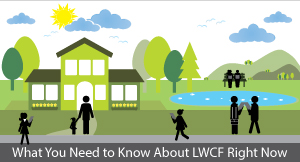Gateway Park in Fort Worth, Texas is a treasured community park. Close to home for many, this park is a prime destination for outdoor recreation, with trails, fields and waterways. This park is a place where the community can gather, connect with nature and improve their quality of life.
Gateway Park is also a success story – a success story of the Land and Water Conservation Fund (LWCF) State Assistance Program – one of over 40,000 LWCF State Assistance program successes across America, to be exact. That’s why it was only fitting that last week’s announcement of this year’s funding for the LWCF State Assistance Program was made in Gateway Park.
 In case you missed it, $43 million will be distributed to all 50 States, Territories and the District of Columbia. The DOI provides a state-by-state breakdown of the funding so you can see how your state fared.
In case you missed it, $43 million will be distributed to all 50 States, Territories and the District of Columbia. The DOI provides a state-by-state breakdown of the funding so you can see how your state fared.
I was in Fort Worth on the day of the announcement meeting with Interior Secretary Sally Jewell and Fort Worth Mayor Betsy Price to not only celebrate the 50th anniversary of LWCF but to continue to share our message that local, close-to-home parks are critical to the economy, the environment and the overall vitality of our people. And you know what? There was much agreement in the room.
This showing of support is great, but without the support of our leaders on Capitol Hill, the LWCF faces an uncertain future. The law expires – done, finished, gone – in 2015, unless Congress takes action to renew it.
Here are a few things to know about this year’s LWCF State Assistance Program Funding:
- This year’s funding is slightly higher than recent years past, which is a positive indication of the support for local parks and recreation – but let’s not get ahead of ourselves, it is still far less than what is truly needed.
- Each federal dollar in the State Assistance Program is matched locally, meaning that this year’s funding will be leveraged by an additional $43 million – at least – in support of close-to-home, outdoor recreation.
- President Obama’s budget request includes a legislative proposal to establish mandatory, full funding for LWCF programs beginning in 2015.
- Congress is currently debating the funding for LWCF in 2015 and needs to hear from all of us if we’re to even maintain level funding for the State Assistance Program next year. Important to note, LWCF has been funded by using a small portion of federal revenues from offshore energy production for five decades. It actually has no impact on the federal deficit and existing and future energy revenues are over five-times the amount necessary for full funding.
Efforts to address national issues such as jobs, conservation of natural resources and the childhood obesity epidemic will be successful only if implemented at the community level. The LWCF State Assistance Program has proven time and again that it is one of the most effective tools for protecting open space, helping urban parks and connecting all people to beneficial park and recreation opportunities.
We must continue to urge Congress to fully fund the LWCF now – including the State Assistance Program – AND, to support its reauthorization with permanent and dedicated funding in the future.
What successes in your community can you attribute to the LWCF State Assistance Program? Share them in the comments or tweet them to @NRPA_News.
Barbara Tulipane, CAE, is NRPA's president and CEO.

